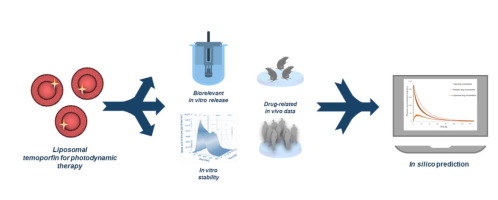当前位置:
X-MOL 学术
›
Eur. J. Pharm. Biopharm.
›
论文详情
Our official English website, www.x-mol.net, welcomes your feedback! (Note: you will need to create a separate account there.)
Predicting human pharmacokinetics of liposomal temoporfin using a hybrid in silico model.
European Journal of Pharmaceutics and Biopharmaceutics ( IF 4.9 ) Pub Date : 2020-02-06 , DOI: 10.1016/j.ejpb.2020.02.001 Laura Jablonka 1 , Mukul Ashtikar 1 , Ge Fiona Gao 2 , Manuela Thurn 1 , Harshvardhan Modh 3 , Jiong-Wei Wang 4 , Annegret Preuß 5 , Dietrich Scheglmann 6 , Volker Albrecht 6 , Beate Röder 5 , Matthias G Wacker 3
European Journal of Pharmaceutics and Biopharmaceutics ( IF 4.9 ) Pub Date : 2020-02-06 , DOI: 10.1016/j.ejpb.2020.02.001 Laura Jablonka 1 , Mukul Ashtikar 1 , Ge Fiona Gao 2 , Manuela Thurn 1 , Harshvardhan Modh 3 , Jiong-Wei Wang 4 , Annegret Preuß 5 , Dietrich Scheglmann 6 , Volker Albrecht 6 , Beate Röder 5 , Matthias G Wacker 3
Affiliation

|
Over the years, the performance of the liposomal formulations of temoporfin, Foslip® and Fospeg®, was investigated in a broad array of cell-based assays and preclinical animal models. So far, little attention has been paid to the influence of drug release and liposomal stability on the plasma concentration-time profile. The drug release is a key attribute which impacts product quality and the in vivo efficacy of nanocarrier formulations. In the present approach, the in vitro drug release and the drug-protein transfer of Foslip® and Fospeg® was determined using the dispersion releaser technology. To analyze the stability of both formulations in physiological fluids, nanoparticle tracking analysis was applied. A comparable drug release behavior and a high physical stability with a vesicle size of approximately 92±2nm for Foslip® and at 111±5 nm for Fospeg® were measured. The development of a novel hybrid in silico model resulted in a level A in vitro-in vivo correlation. Based on the information available for previous formulations, the model enabled a prediction of the performance of Foslip® in humans. To verify the simulations, plasma concentration-time profiles of a phase I clinical trial were used. An absolute average fold error of 1.4 was achieved. Moreover, a deconvolution of the pharmacokinetic profile into different fractions relevant for the in vivo efficacy and safety was achieved While the total plasma concentration reached a cmax of 2298 ng/mL after 0.72 h, the monomolecular drug accounted for a small fraction of the photosensitizer only with a cmax of 321 ng/mL.
中文翻译:

使用混合计算机模拟模型预测脂质体替莫泊芬的人药代动力学。
多年来,在广泛的基于细胞的试验和临床前动物模型中研究了替莫泊芬脂质体制剂Foslip®和Fospeg®的性能。到目前为止,很少关注药物释放和脂质体稳定性对血浆浓度-时间曲线的影响。药物释放是影响产品质量和纳米载体制剂的体内功效的关键属性。在本方法中,使用分散释放剂技术确定了Foslip®和Fospeg®的体外药物释放和药物-蛋白质转移。为了分析两种制剂在生理流体中的稳定性,应用了纳米颗粒跟踪分析。测量了相当的药物释放行为和高物理稳定性,囊泡尺寸对于Foslip®约为92±2nm,对于Fospeg®在111±5 nm。新型混合计算机模型的开发导致了A级体内外相关性。基于先前配方的可用信息,该模型可以预测Foslip®在人体中的性能。为了验证模拟,使用了I期临床试验的血浆浓度-时间曲线。绝对平均折叠误差为1.4。此外,还可以将药代动力学图谱解卷积为与体内功效和安全性相关的不同部分,而总血浆浓度在0.72 h后达到cmax为2298 ng / mL,
更新日期:2020-02-07
中文翻译:

使用混合计算机模拟模型预测脂质体替莫泊芬的人药代动力学。
多年来,在广泛的基于细胞的试验和临床前动物模型中研究了替莫泊芬脂质体制剂Foslip®和Fospeg®的性能。到目前为止,很少关注药物释放和脂质体稳定性对血浆浓度-时间曲线的影响。药物释放是影响产品质量和纳米载体制剂的体内功效的关键属性。在本方法中,使用分散释放剂技术确定了Foslip®和Fospeg®的体外药物释放和药物-蛋白质转移。为了分析两种制剂在生理流体中的稳定性,应用了纳米颗粒跟踪分析。测量了相当的药物释放行为和高物理稳定性,囊泡尺寸对于Foslip®约为92±2nm,对于Fospeg®在111±5 nm。新型混合计算机模型的开发导致了A级体内外相关性。基于先前配方的可用信息,该模型可以预测Foslip®在人体中的性能。为了验证模拟,使用了I期临床试验的血浆浓度-时间曲线。绝对平均折叠误差为1.4。此外,还可以将药代动力学图谱解卷积为与体内功效和安全性相关的不同部分,而总血浆浓度在0.72 h后达到cmax为2298 ng / mL,



























 京公网安备 11010802027423号
京公网安备 11010802027423号